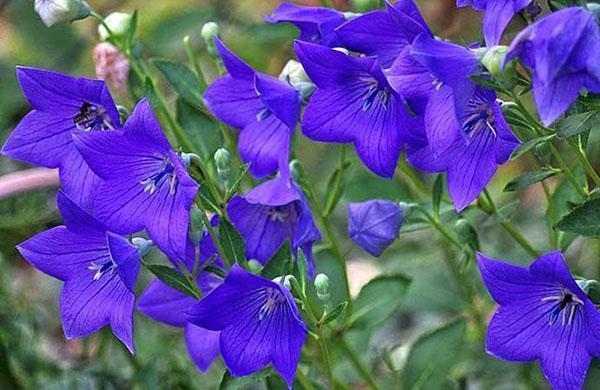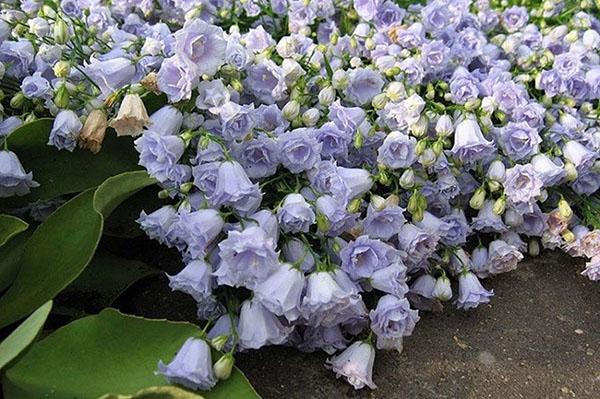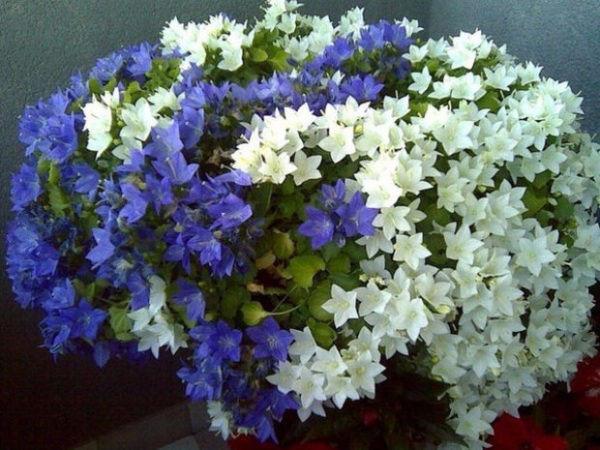Meet different types and varieties of wonderful bells in your garden
 The bell plant is found in almost every region of the world. It is so widespread and unpretentious that it adorns the meadows of harsh Siberia and the mountains of sunny Corfu. The flower is delicate, weather-resistant, used in landscaping and to create so-called gardens in a natural style.
The bell plant is found in almost every region of the world. It is so widespread and unpretentious that it adorns the meadows of harsh Siberia and the mountains of sunny Corfu. The flower is delicate, weather-resistant, used in landscaping and to create so-called gardens in a natural style.
Variety of species and varieties
In the special literature, there are about 300 species of bell - campanula. Most of them are perennials growing in forests and meadows. There are biennials and annuals. Among the cultivated species, 100 are known that are most often used in garden design.
Breeders have also bred hybrid varieties that have double inflorescences, and the color range differs in intensity compared to wild ones. Below in the photo is a flower bell spoon-leaved.
In garden design, most campanula are grown as biennials. If the plant is not renewed and transplanted to a new place every 2-3 years, it becomes smaller and may die. The exception is tall varieties. In addition to life expectancy, all campanules are divided into:
- undersized;
- medium-sized;
- tall.
Low species are mainly mountain plants up to 15 cm high. Their natural habitat is foothills and mountain slopes. They prefer a dry climate in combination with stony soil. Their cultivars are used to decorate borders, alpine slides.
Medium and tall species are inhabitants of forests and meadows. They love fertile soils, sunny or semi-shady areas. There are also house flowers bells, bred specifically for living in indoor conditions. Their ancestor is considered to be an equifolia bell, originally from the Mediterranean. It is a compact plant, abundant flowering, inhabiting mountain slopes.
 The most common representative of indoor bells is the bride and groom with white and blue inflorescences.
The most common representative of indoor bells is the bride and groom with white and blue inflorescences.
Indoor bell is a whimsical plant that requires compliance with seasonal conditions.
In general, dozens of plant varieties have been bred for home cultivation, which differ in the longest flowering period - from March to October. This is impossible to achieve outdoors.
The bell is a typical representative of the wild-growing flora, but it gained popularity in landscape gardening design and has been decorating both pompous Italian gardens and modest English courtyards for more than 5 centuries.
Carpathian bell: description, growing from seeds
 It is the most common inhabitant of garden rockeries and alpine slides. Very beautiful and fragile at first glance, it is distinguished by winter hardiness and the longest flowering period - 65-75 days. Above in the photo, the Carpathian bell is shown in natural growing conditions.
It is the most common inhabitant of garden rockeries and alpine slides. Very beautiful and fragile at first glance, it is distinguished by winter hardiness and the longest flowering period - 65-75 days. Above in the photo, the Carpathian bell is shown in natural growing conditions.
Botanical description of the plant:
- perennial herb;
- height 10-20 cm;
- thin leafy shoots;
- leaves ovate with short petioles;
- flowers bells with a diameter of 4 cm, directed upwards.
The plant propagates by seeds or by dividing the bush. In regions with mild winters, it produces self-seeding. Carpathian bellflower seeds are grown from seedlings. The seeds are sown in February in boxes with fertile and breathable soil.
The seeds are very small, so they are scattered over a moistened surface and pressed with the palm of your hand. Additionally, you can moisten the soil with a spray bottle.
The seeds are germinated in the light under glass. Seedlings appear in 2 weeks. After another 3 weeks, young shoots dive into more spacious containers, followed by transplantation into open ground in May. The Carpathian bell loves well-lit areas with drained soils. Does not tolerate stagnant water. In the garden, they are planted with other ground covers at a distance of at least 20 cm, as it grows rapidly.
Of the cultivated varieties, the Carpathian bell Alba, White Star, Isabelle, Chenton Joy are distinguished, which have white, purple and blue flower colors.


Bell peach
 Distributed throughout the European part of Russia and other CIS countries. Recognizable inhabitant of wild meadows and forests. In natural nature, it most often has blue flowers, multiplies by self-seeding. Rarer varieties have white and purple inflorescences.
Distributed throughout the European part of Russia and other CIS countries. Recognizable inhabitant of wild meadows and forests. In natural nature, it most often has blue flowers, multiplies by self-seeding. Rarer varieties have white and purple inflorescences.
Bell Description:
- perennial;
- height from 40 to 100 cm and above;
- the stem is erect;
- leaves are lanceolate, narrow, dark green;
- inflorescences bells are collected in a brush of 3-8 pieces;
- flowering period June-July;
- the fruit box ripens in September.
The peach bellflower prefers drained soils and partial shade. Naturally occurs on forest edges, in humid ravines, along river banks in the shade shrubs... When grown in the garden, it does not require fertilizing and watering. Used as a plant of the second and third plan. Young leaves and roots of the plant can be used for food.
Bell middle
 A resident of the foothills of the Caucasus, Siberia and even America, the middle bell belongs to biennial herbaceous plants. It has been known in the garden culture since the 16th century. Loves moist soils, coolness and does not tolerate heat and frost.
A resident of the foothills of the Caucasus, Siberia and even America, the middle bell belongs to biennial herbaceous plants. It has been known in the garden culture since the 16th century. Loves moist soils, coolness and does not tolerate heat and frost.
Description of the plant:
- height from 50 to 100 cm;
- stem straight, pubescent;
- root rosette of leaves;
- diameter of flowers 6-7 cm, located along the entire length of the stem;
- flowering from June to August;
- inflorescences of blue, white, pink or purple.
In a favorable climate, the plant reproduces by self-sowing, the seeds ripen in August-September. The flower is considered a good honey plant. Its inflorescences bloom alternately from bottom to top, due to which it has such a long decorative period.
How and when to plant? Cultivation from seeds of a middle bell is carried out through planting in boxes for seedlings or in open ground. In the first case, you can achieve flowering biennial in the current year, and in the second case - in the future.
If you sow a bell for seedlings, choose the period from late January to February.
Seeds are not sprinkled with soil, germinated in containers in the light. Seedlings are transplanted to a permanent place in May-June. At first, it is a dense rosette of leaves, which gives 1 stem with alternately forming buds. The bell will bloom in July this year and next year in June.
To get a strong plant next year, seeds are sown in open ground in June, lightly sprinkled with soil. Until autumn, young sockets will get stronger and they are transplanted to a permanent place. The distance between the plants is at least 10 cm. After 2 years, the planting is renewed.
Crowded bell
 A plant that grows equally well in partial shade and in sunny areas. In the wild, it occurs at the edges of forests in thickets of bushes and grass. It blooms earlier in the sun, but inflorescences are smaller. In the shade, it forms fluffy caps of blue, purple and rarely white bells.
A plant that grows equally well in partial shade and in sunny areas. In the wild, it occurs at the edges of forests in thickets of bushes and grass. It blooms earlier in the sun, but inflorescences are smaller. In the shade, it forms fluffy caps of blue, purple and rarely white bells.
Description of the plant:
- perennial, up to 60 cm high;
- forms bushes of several stems that can be divided;
- leaves are alternate, smooth outside, without petioles;
- small flowers with a diameter of 2 cm, collected in a brush at the top of the stem, 20 pieces each;
- flowering from June to August 40 days;
- winter hardy, unpretentious.
The plant propagates by seed and dividing the bush.When to plant a crowded bell in open ground? This can be done throughout the warm season. The plant quickly takes root and takes root. If the transplant is carried out during flowering, it is better to cut off the inflorescences. Unlike other bluebells, this species remains decorative after flowering due to its dense green leaves and compact bush shape.
Broadleaf bell
 Disease and pest resistant species, distributed from Europe to Asia Minor. Found everywhere in shady gardens and pine or spruce forests, along river banks. Propagated by self-seeding in the wild and by dividing the bush in the garden.
Disease and pest resistant species, distributed from Europe to Asia Minor. Found everywhere in shady gardens and pine or spruce forests, along river banks. Propagated by self-seeding in the wild and by dividing the bush in the garden.
Broad-leaved bell is a tall plant up to 120 cm with inflorescences at the top of the stem. Due to deforestation, the growing area has narrowed, so today the plant is listed in the Red Book.
Botanical Description:
- erect pubescent stem, average height 90 cm;
- leaves are large, pointed, become smaller towards the top;
- flowers are small, collected in capitate inflorescences at the very top of the stem;
- the color of the flowers is violet-blue, white or pink;
- the edges of the flowers are wavy;
- blooms from July to August;
- the fruit is a box.
The plant loves fertile soils, partial shade and moderate moisture. When grown from seed, the flower stem develops in the second or third year after planting. It grows in one place for 10-15 years, requires rare fertilizing and watering only during dry periods.
In the garden, it is planted in groups near the shrubs, so that in the midday heat, the flower is in their shade. Looks good at fence, near the gazebo or other buildings.
Bellflower milky-flowered
 The most beautiful and abundantly flowering species of all known in nature is the milk-flowered bell. It is represented by tall varieties with a stem length up to 160 cm and undersized varieties up to 40 cm high. The plant is unpretentious, but does not like transplanting, therefore, after purchase, it is immediately planted in a permanent place.
The most beautiful and abundantly flowering species of all known in nature is the milk-flowered bell. It is represented by tall varieties with a stem length up to 160 cm and undersized varieties up to 40 cm high. The plant is unpretentious, but does not like transplanting, therefore, after purchase, it is immediately planted in a permanent place.
What does a milk-flowered bell look like? Tall varieties release a powerful arrow, strewn with peduncles. The flowers are fragrant, small, white, blue and less often pink, up to 4 cm in diameter. The flowering period lasts from July to September or October under favorable weather conditions. Mature plants require support during flowering, propagate well by cuttings.
In care, they require nutrition and regular hilling. In landscape design, they are used in single plantings, as they are highly decorative, which overlaps the beauty of other plants in the garden.
Low-growing varieties are represented by compact ground covers, rapidly growing and not demanding on the composition of the soil. Propagated by seeds and dividing the bush. In one place they can grow up to 7 years.
Pozharsky's bell
 One of the few creeping bells. It is a perennial, which is highly decorative not only during flowering. All thanks to the original leaves that form a dense curly head of the bush. In width, due to creeping shoots, the Pozharsky's bell grows by 80 cm, and in height - only 20 cm.
One of the few creeping bells. It is a perennial, which is highly decorative not only during flowering. All thanks to the original leaves that form a dense curly head of the bush. In width, due to creeping shoots, the Pozharsky's bell grows by 80 cm, and in height - only 20 cm.
Botanical Description:
- perennial ground cover;
- creeping stems;
- leaves are rounded small with jagged edges;
- flowers are small, like stars with petals bent downwards;
- flower color is predominantly violet-blue;
- blooms from July to August;
- inflorescences are fragrant, good honey plants.
Cultivars of this species have lavender, purple, white and blue flowers. Due to its rapid growth, unpretentiousness, winter hardiness and drought resistance, the plant is widely used in landscape design. The bell adorns alpine slides, slopes, rockeries, lawn edges, curbs. Propagated by seeds and dividing the bush in spring or autumn after flowering.
Cultivated varieties:
- Stella - blue flowers with a white center;

- Blue Gown - dwarf, 15 cm high, blue inflorescences;

- Lizdugan Variety - height 20 cm, small pink inflorescences.

In the garden, Pozharsky's bell goes well with saxifrage, cloves and dwarf conifers.
Bell of a porthole
 An early flowering compact perennial - the bell of a porthole. It became known only at the beginning of the 19th century. The homeland is the foothills of Croatia, but today it is cultivated in many temperate regions.
An early flowering compact perennial - the bell of a porthole. It became known only at the beginning of the 19th century. The homeland is the foothills of Croatia, but today it is cultivated in many temperate regions.
Differs in good winter hardiness and long flowering, which lasts from June to September, covering the bush with a lush cap of blue inflorescences.
Description of the plant:
- undersized perennial up to 25 cm high;
- funnel-shaped flowers up to 2.5 cm in diameter;
- stems are erect, 3-5 inflorescences are formed on the crown;
- leaves are dark green toothed;
- inflorescences are blue, white, purple, lavender.
It is interesting that the plant remains decorative all year round, since the strong greenery does not freeze in winter. They cut it only in the first spring months to give free rein to young shoots.
The bell is propagated by seeds or vegetatively. When planting seedlings in open ground, maintain a distance of 10 cm. For the winter, an adult plant does not require shelter.
Point bell
 A highly decorative plant native to China and Korea. Differs in a dense head of large drooping flowers that do not fully open. A dotted bell blooms from mid-summer to the very frost, subject to the timely removal of dry inflorescences.
A highly decorative plant native to China and Korea. Differs in a dense head of large drooping flowers that do not fully open. A dotted bell blooms from mid-summer to the very frost, subject to the timely removal of dry inflorescences.
Botanical description of the species:
- stems straight, pubescent up to 70 cm high;
- leaves are small, ovate on short petioles, pubescent;
- inflorescences are large, up to 6 cm in diameter, drooping, on long pedicels;
- one shoot forms 5-6 inflorescences, which bloom gradually;
- bloom from July to October.
The corolla of the flower is covered with purple dots on the outside, from which the plant gets its name. In landscape design, the following decorative varieties of the dotted bell are most often used:
- Garland - height 40 cm, inflorescences 8 cm in diameter, purple, densely covering the stem;

- Pink Red - height 50 cm, the largest inflorescences - 9 cm in diameter, collected in panicles. The color of the flower is pink;

- Ash Sensation - height 55 cm, goblet purple flowers, glossy leaves.

In landscape design, it is used in single and group plantings in combination with white and gray ground covers.
Sprawling bell
 A typical representative of the genus, distributed throughout Europe. It is the spreading bell that you must meet in wild meadows and pastures. It differs from other representatives by a fragile branching stem and a loose panicle of inflorescences.
A typical representative of the genus, distributed throughout Europe. It is the spreading bell that you must meet in wild meadows and pastures. It differs from other representatives by a fragile branching stem and a loose panicle of inflorescences.
Description:
- herbaceous biennial;
- height 40-60 cm;
- stem thin, ribbed, well branched;
- inflorescences on long peduncles of medium diameter violet-blue;
- leaves are lanceolate, narrow.
Blooms from mid-June in the second year of life. In natural nature, rarely forms glades, is very sensitive to trampling, propagates by seeds.
Flowers bells are perennial or biennial representatives of cultural and wild flora. As annuals, they are grown only in the garden and are not so popular. The species and varietal diversity is impressive, but knowing the brightest representatives of the genus, you can create a beautiful landscape in the garden, the decoration of which will be a gentle and modest campanula.